Section 1.19
Piston and Piston Ring
Non-premium engines use pistons with cast iron domes and skirts and open-end connecting rods. Premium engines (identified by the letters "PK" or "BK" in the fifth and sixth positions of the model number) built on or after March 16, 1998 use pistons with forged steel domes, aluminum skirts, and closed-end connecting rods. High torque engines (identified with "FK" or "HK" in the model number) also uses a steel piston, but of a larger diameter (14L).
Note: Steel and cast iron cylinder components must not be mixed in an engine.
The cast iron cross-head piston is a two-piece piston consisting of a dome and a skirt. The dome and skirt are held together by the piston pin. Ring grooves are machined in the piston dome. See Figure "Cast Iron Piston and Related Parts" .

|
1. Piston Pin |
5. Oil Ring Expander |
|
2. Piston Skirt |
6. Oil Control Ring |
|
3. Three-piece Bushing |
7. Compression Ring |
|
4. Piston Dome |
8. Fire Ring |
Figure 1. Cast Iron Piston and Related Parts
Note: Series 60G engine incorporates a 3.5 mm fire ring, a rectangular cut compression ring and a three-piece oil ring. See Figure "Three–piece Gas Oil Ring" . The compression ring is identified with a purple stripe.
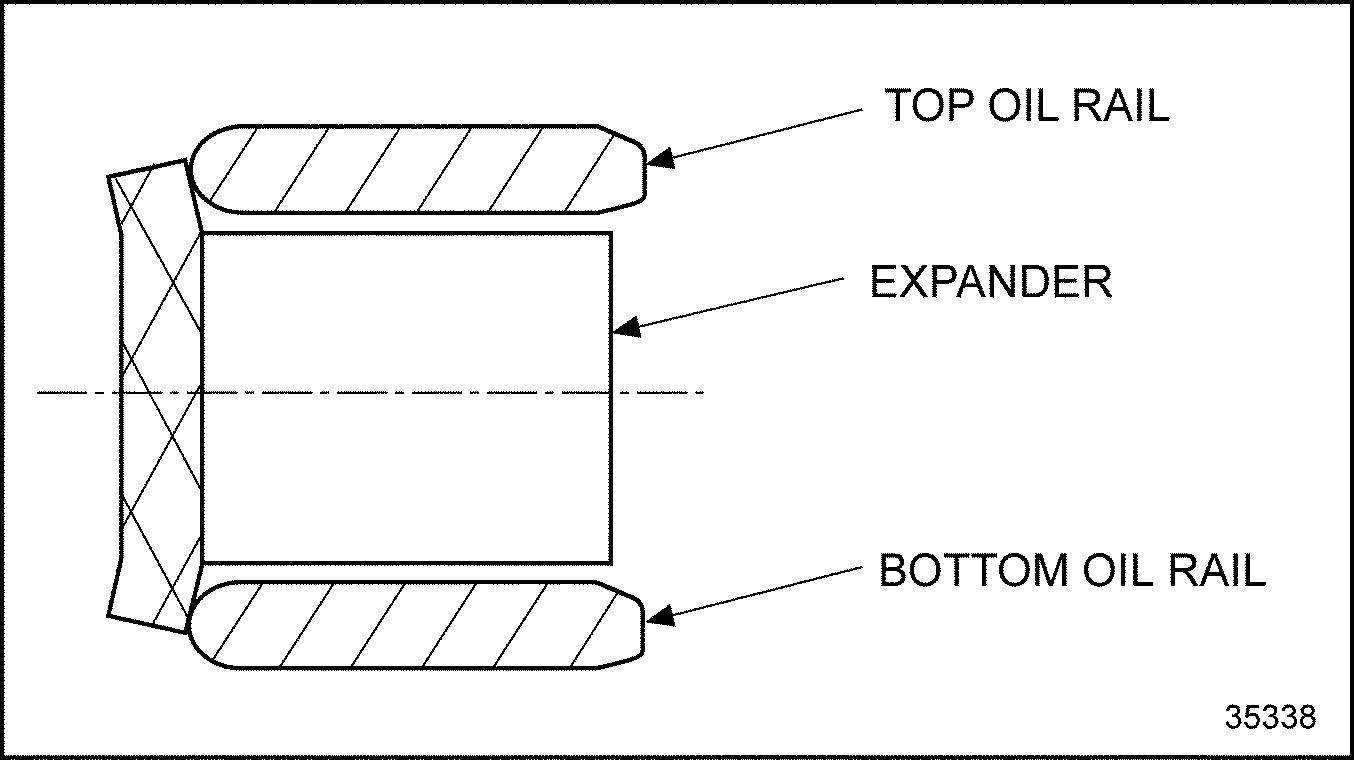
Figure 2. Three–piece Gas Oil Ring
Each piston is fitted with a fire ring, compression ring and one-piece oil control ring with expander. See Figure "Piston Ring Location" , and see Figure "Comparison of Piston Ring Packs" .
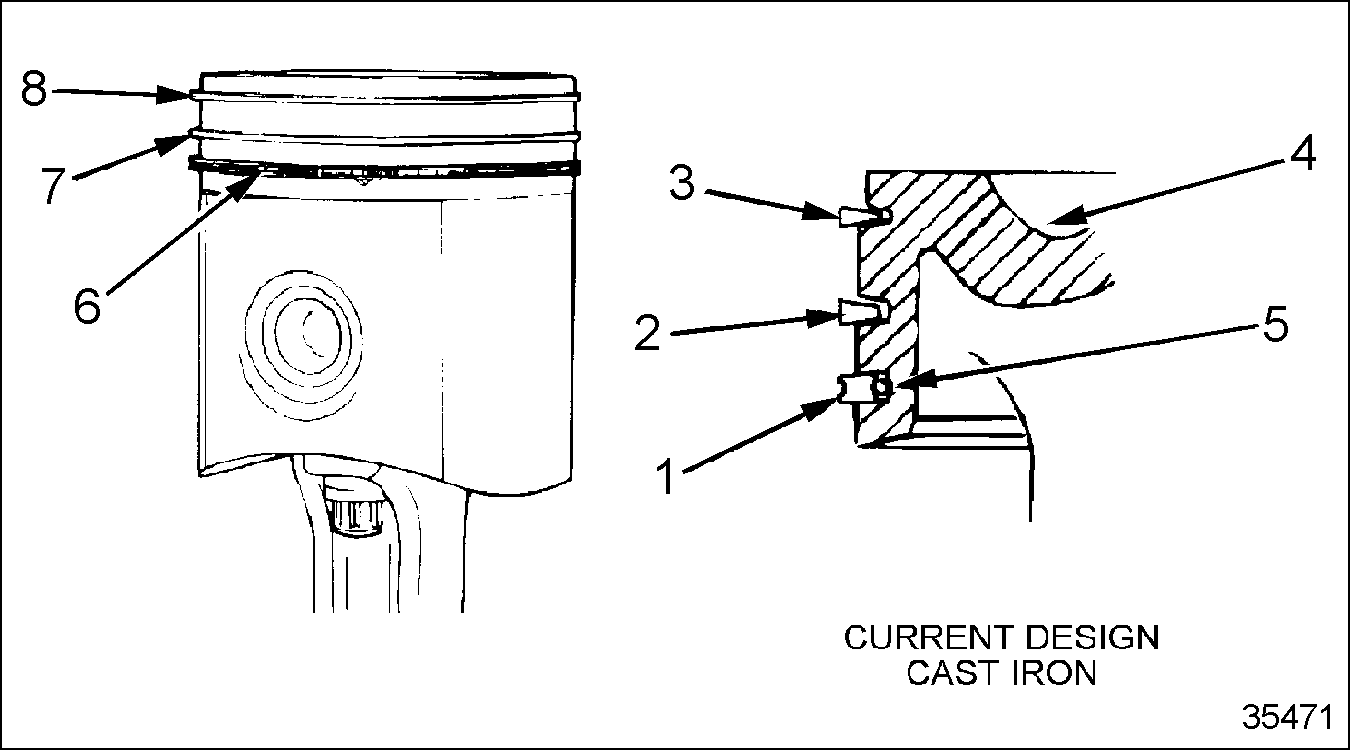
|
1. Oil Control Ring |
5. Oil Ring Expander |
|
2. Compression Ring* |
6. Oil Control Ring |
|
3. Fire Ring |
7. Compression Ring* |
|
4. Piston Dome |
8. Fire Ring* |
* Identification Mark to Face Top of Dome
Figure 3. Piston Ring Location

Figure 4. Comparison of Piston Ring Packs
The forged steel cross-head piston is two-piece piston consisting of a dome and a skirt. The dome and skirt are held together by the piston pin. Ring grooves are machined in the piston dome. See Figure "Forged Steel Piston and Related Parts" .
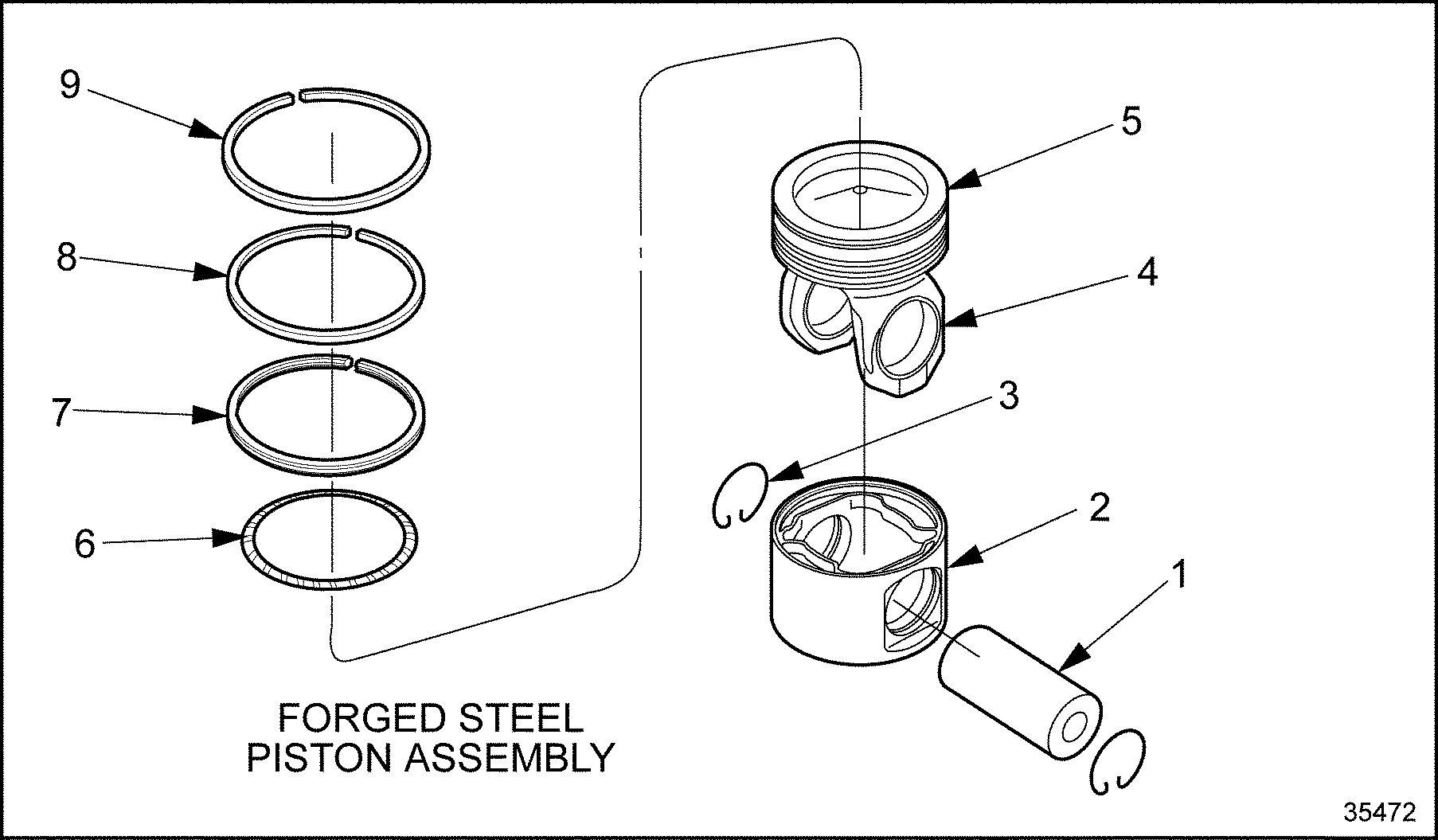
|
1. Piston Pin |
6. Oil Ring Expander |
|
2. Piston Skirt |
7. Oil Control Ring |
|
3. Snap Ring |
8. Compression Ring |
|
4. Piston Pin Bushing |
9. Fire Ring |
|
5. Piston Dome |
Figure 5. Forged Steel Piston and Related Parts
Each piston is fitted with a fire ring, compression ring, and one-piece oil control ring with expander.
The fire and compression rings are installed with the "football" mark facing up, see Figure "Fire and Compression Ring Identification" .

Figure 6. Fire and Compression Ring Identification
A one-piece oil control ring is used in the third groove. The expander is of Spira-Lox construction.
The forged steel piston uses a floating piston pin which rides on the one-piece bushing pressed into the end of the connecting rod.
The connecting rod and solid-core piston pin do not have drilled center orifices for lubrication. Oil for lubrication and cooling is supplied by oil spray from piston-cooling nozzles installed at the bottom of each piston bore.
During engine operation, gas loads pushing down on the piston dome are taken directly by the piston pin and connecting rod bushing. The piston skirt, being separate, is free from vertical load distortion. Thermal distortion is also reduced as the piston dome expands. As the connecting rod swings to one side on the downward travel of the piston, the major portion of the side thrust is taken by the piston skirt.
Two oil relief channels are drilled into the oil ring groove area, on each side of the dome, just above the piston pin bore. These channels are not drilled through the piston. The channels help the excess oil, scraped from the cylinder walls, return to the crankcase. See Figure "Piston Oil Relief Channels" .
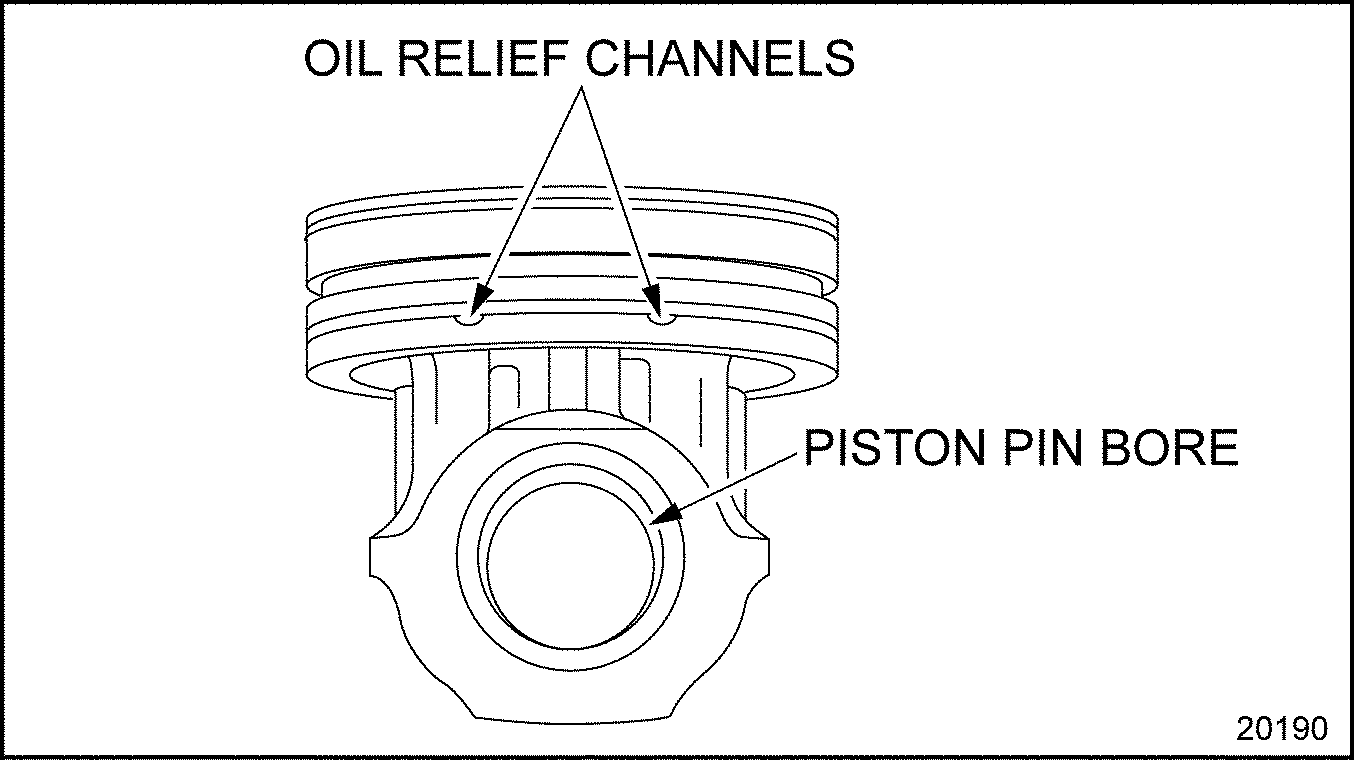
Figure 7. Piston Oil Relief Channels
Two cast iron dome designs have been used in Series 60 engines. The earlier design had a non-serviceable bearing. The piston dome and piston pin bearing of the most recent design are separate parts and may be serviced separately.
Two special bolts and spacers are used to attach the connecting rod to the piston pin.
The solid-core piston pin has a drilled hole through the center to provide lubricating oil to the piston dome for cooling. A threaded hole on each side of the oil hole receives the connecting rod attaching bolts. See Figure "Piston Pin Cross Section" .
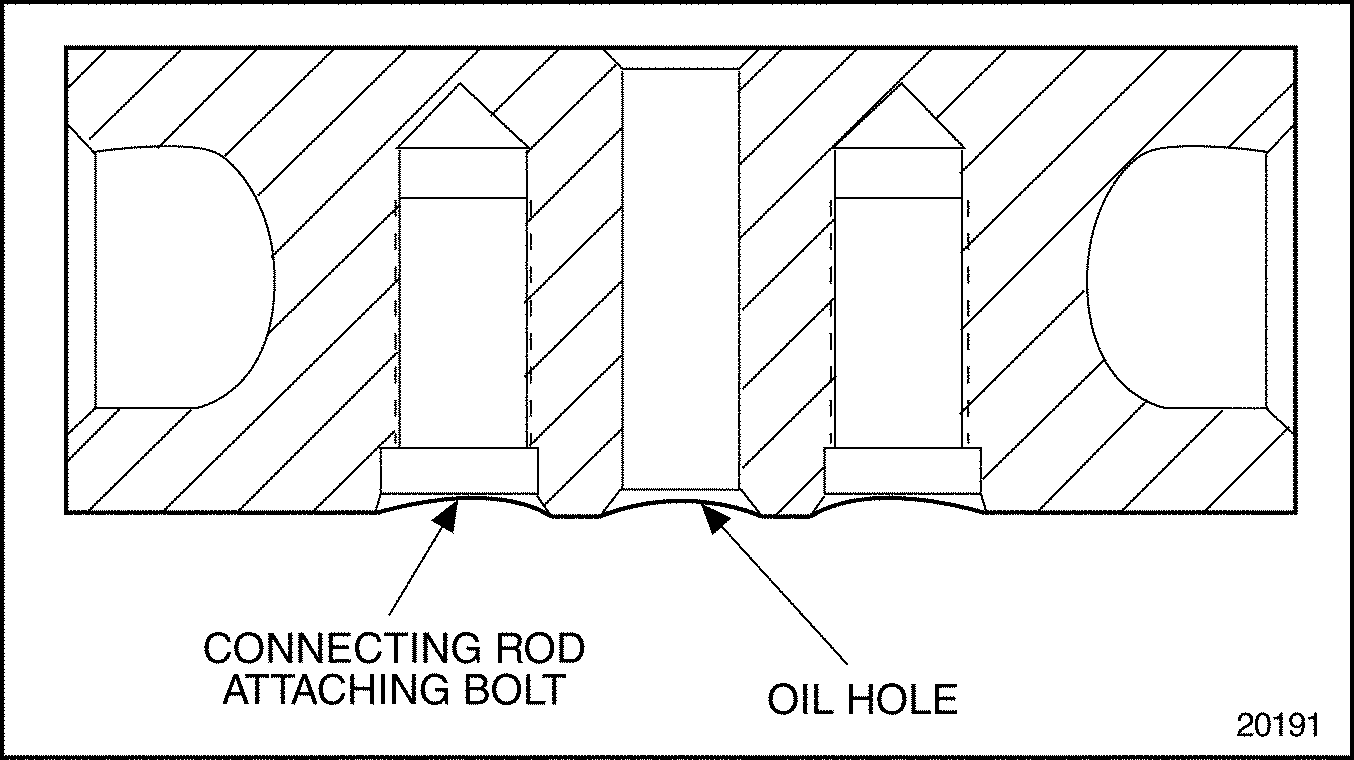
Figure 8. Piston Pin Cross Section
Internal parts of the piston are lubricated and cooled by the engine lubricating oil. Oil is pressure-fed up the drilled passage in the connecting rod, through the piston pin, then through the center hole in the bearing to the underside of the piston dome. A portion of the oil lubricates the piston pin and bearing.
During engine operation, gas loads pushing down on the piston dome are taken directly by the piston pin and bearing. The piston skirt, being separate, is free from vertical load distortion. Thermal distortion is also reduced as the piston dome expands. As the connecting rod swings to one side on the downward travel of the piston, the major portion of the side thrust is taken by the piston skirt.
Section 1.19.1
Repair or Replacement of Piston and Piston Ring
To determine if repair is possible or replacement is necessary, perform the following procedure. See Figure "Flowchart for Repair or Replacement of Piston and Piston Rings" .
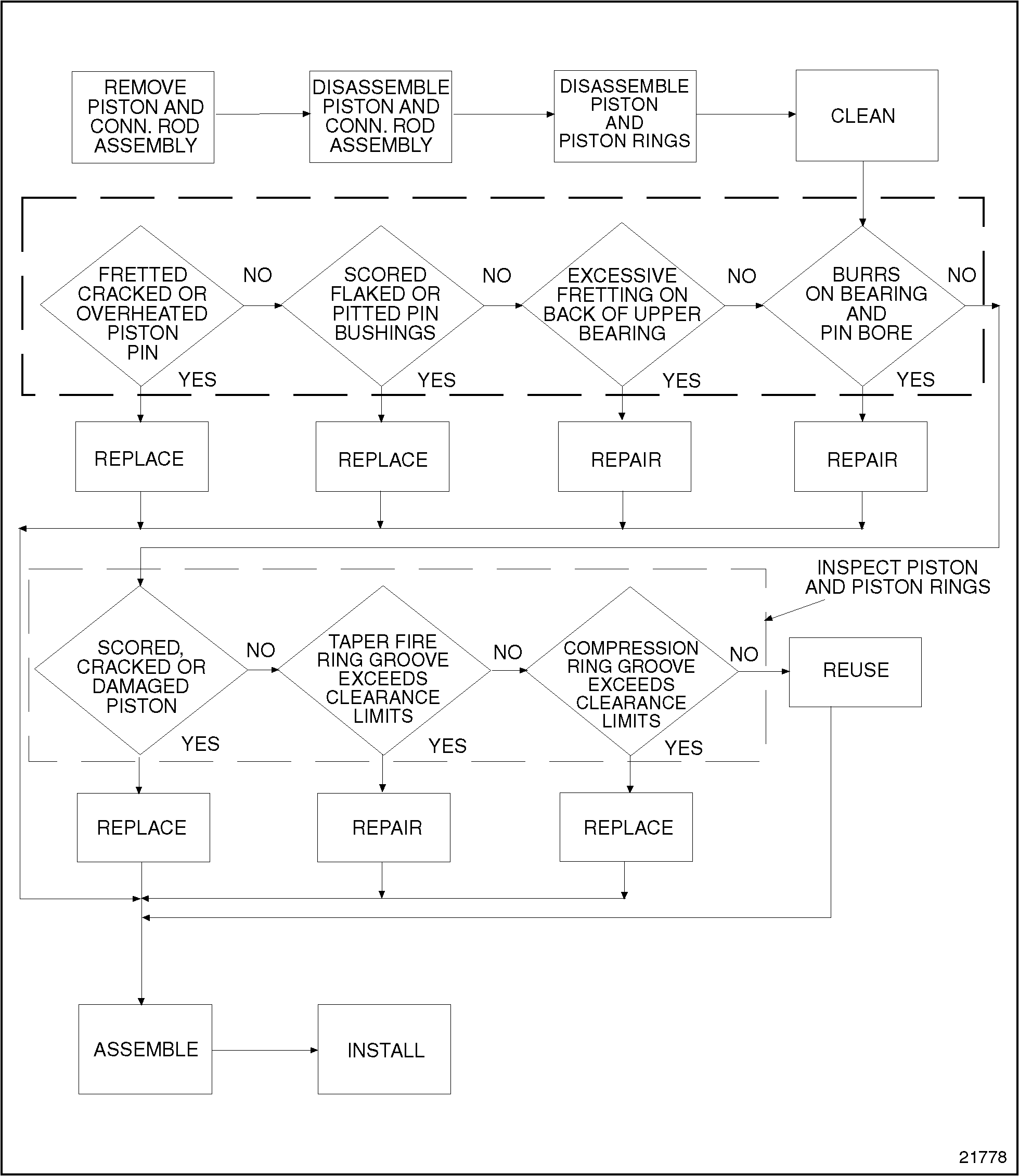
Figure 9. Flowchart for Repair or Replacement of Piston and Piston Rings
Section 1.19.2
Removal and Cleaning of Piston and Piston Ring
Refer to "1.21.2 Removal and Cleaning of Piston and Connecting Rod" for piston and connecting rod assembly removal procedure.
Section 1.19.3
Disassembly of Piston and Piston Ring
Disassemble the piston and piston rings as follows:
- Remove the piston rings with piston ring expander tool.See Figure
"Removal of Piston Rings"
.

Figure 10. Removal of Piston Rings
NOTICE:
The pin, bushing, skirt and dome must be match-marked to assure proper position and orientation.
- Withdraw the piston pin and mark the front of the piston with a paint pencil, so it can be returned to the correct cylinder location.
Note: Steel pistons will require the removal of the circlip before withdrawing the piston pin.
- Perform the following steps on current cast iron domes:
- Separate the piston skirt from the piston dome and mark the front of the dome ear and skirt with a paint pencil, so they can be returned to the correct location.
- Remove the piston pin bearings, marking the front of them with a paint pencil, so they can be returned to the correct location.
Note: Bearings are not serviced separately on steel pistons.
Note: The lower pin bore bearings are removed from the pin bore first, by pushing the bearing legs outward by hand at the split lines from inside the dome saddle ear. The upper bearing may be held in the bore by oil on the back of the bearing, making removal from the pin bore by hand difficult.
|
EYE INJURY |
|
To avoid injury from flying debris when using compressed air, wear adequate eye protection (face shield or safety goggles) and do not exceed 276 kPa (40 psi) air pressure. |
NOTICE: |
|
Prying between the bearing back and dome bore may damage the dome saddle bore or raise burrs which will make installation of new bearings difficult. |
DDC recommends that compressed air be directed between the dome pin bore and back of the bearing at one end until the bearing pops up out of the bearing retaining hole.
Section 1.19.3.1
Inspection of Piston and Piston Rings
Clean the piston and piston rings prior to inspection as follows:
NOTICE: |
|
Do not attempt to clean the piston skirt by glass beading. It will remove the tinplating. Do not refinish or polish the piston pin. |
- Clean the piston components with fuel oil.

EYE INJURY
To avoid injury from flying debris when using compressed air, wear adequate eye protection (face shield or safety goggles) and do not exceed 276 kPa (40 psi) air pressure.
- Dry the piston components with compressed air.
- If fuel oil does not remove the carbon deposits, use a chemical solvent that will not harm the tinplate on the piston skirt.
NOTICE:
After cleaning, do not leave glass beads in the piston dome. Do not allow the glass beading to contact any area of the piston pin bushing or pin bore. Glass beading will remove the tinplating.
- The piston dome, including the compression ring grooves, is not tin-plated and may be wire-brushed to remove any hard carbon. Glass beading can be used to clean a piston dome. Micro Bead Glass Shot MS-M 0.0736-0.1473 mm (0.0029 -0.0058 in.) is recommended. The machine used for this process must be able to withstand air pressures of 552-689 kPa (80-100 psi).
Note: Do not wire-brush the piston skirt.
- Clean the ring grooves with a suitable tool or a piece of an old compression ring that has been ground to a bevel edge.
- Clean the inside surfaces of the piston dome and skirt and the oil relief channels in the oil ring grooves.
Inspect the piston and piston rings as follows:
- Inspect the piston skirt and dome.
- Check the skirt and dome for score marks, cracks, damaged ring grooves or overheating indications.
- If any of these indications are present, replace the piston.
Note: Burn spots may indicate an obstruction in the connecting rod or piston pin oil passage.
- Inspect the tapered fire ring groove (top) in the piston dome.
- Using the piston ring land step gage (J–35884–A) (2.5 mm ring groove) or gage (J–38609–A) (3.5 mm ring groove), check tapered fire ring groove. See Figure "Checking Fire Ring Groove" .
- Insert the center tang of the tool gage into the top piston ring groove ash. See Figure "Checking Fire Ring Groove" .
- Hold the tool at a 90 degree angle to the ring groove to prevent false readings.
- With the center tang into the ring groove as far as it will go, there should be no contact of the piston with the shoulders of the gage. If the gage makes contact at point A or point B, the fire ring groove is worn beyond usable limits. Check the groove clearance at four spots, at 90 degree intervals. Measure the ring land parallel to and at 90 degrees to the wrist pin.
- If fire ring groove is worn beyond usable limits, replace piston dome.

1. Fire Ring Groove
Figure 11. Checking Fire Ring Groove
- Inspect tapered compression ring groove (second) in the piston dome.
- Using piston ring land step gage, check the groove as in the compression ring groove.
- If the compression ring groove is worn beyond usable limits, replace piston dome.
- Inspect the piston pin.
- Check the piston pin for fretting, cracking or signs of overheating.
- If these are detected, replace piston pin.
- Measure piston pin outside diameter. Specifications are listed in Table "Articulated Steel Piston Pin" .
- If piston pin is out of specifications, replace with new part.
Note: If piston pin used with a cast iron piston is replaced for any reason, the piston pin bushing for that cylinder must also be replaced.
Note: If the piston pin used on steel dome engines is replaced for any reason, the dome must also be replaced for that cylinder.
- Inspect the piston pin bushings as follows:
- Check the piston pin bushings for scoring, pitting, flaking, cracking, excessive wear, or signs of overheating.
- If these conditions are present, the bearings must be replaced.
Note: On steel dome engines, if bearing replacement is necessary then the dome assembly must be replaced as well.
Note: Early second keystroke ring (SKR) design piston domes have an integral piston pin bushing. The piston pin bushing cannot be replaced in these piston domes. If there is distress to the piston pin bushing, the entire piston dome assembly must be replaced, with current cast iron design.
NOTICE:
If a piston pin bushing is replaced for any reason, the piston pin for that cylinder must also be replaced.
- Inspect the back of the upper bushing.
- Check the bushing for excessive fretting.
- If excessive fretting is evident, replace all three bushings.
- The corresponding fretting in the piston dome can be removed using crocus cloth, wet with fuel oil.
- On steel piston engines, inspect the connecting rod bushing.
- Check the bushing for excessive fretting.
- If excessive fretting is evident, replace the connecting rod assembly.
- Inspect the edges of the bearings and piston dome pin bore.
- Check the edges of the bearing and piston dome pin bore for dents and dings.
- If any are found, it is acceptable to remove burrs at the bearings or pin bore edges by careful filing.
Note: Remove any dirt or debris on the backs of the bearing or dome pin bore that may take up clearance required for bearing or piston pin installation.
- If the piston pin used with a forged steel piston is replaced for any reason, the connecting rod bushing must be inspected for wear before the rod is installed. If the bushing is worn beyond limits, the connecting rod must be replaced. Refer to "1.19.3.1 Inspection of Piston and Piston Rings" for connecting rod bushing inspection procedure.
- Check the cylinder liner and block bore for excessive out-of-round, taper and high spots which could cause failure of the piston. Specifications are listed in Table "Cylinder Liner" .
- Check the block bore for excessive out-of-round, taper, and high spots that could cause failure of the piston. Specifications are listed in Table "Cylinder Block" .
Section 1.19.4
Assembly of Piston and Piston Rings
Prior to installing the piston rings, the ring gap of each piston ring must be measured.
- Insert the piston rings inside of the cylinder liner one at a time, using a piston dome (inserted upside down into the liner) to push the ring down. The piston dome should be inserted into the liner, to the same depth as the ring being positioned.
- For the oil control ring, insert the piston dome down into the liner, until the oil control ring land is just into the liner. This will ensure that the rings are parallel with the top of the liner, and that they are positioned in the liner within the normal area of ring travel.
- After the three rings have been positioned in the liner, measure the ring gap of the top ring with a feeler gage. See Figure
"Piston Ring Gap Measurement"
. Remove the ring from the liner after the measurement is complete.

Figure 12. Piston Ring Gap Measurement
- Repeat this procedure for each ring, and record your measurements. Allowable ring end gaps are listed in Table
"Allowable Ring End Gap On-Highway Engines"
.
Ring
Ring End Gap
Fire Ring (2.5 mm [0.098 in.] chrome)
0.40 - 0.87 mm (0.016 - 0.034 in.)
14L Fire Ring: 3.0 mm (0.118 in.)
0.60 - 0.85 mm (0.024 - 0.033 in.)
Fire Ring (3.5 mm [0.138 in.] plasma)
0.51 - 0.87 mm (0.020 - 0.034 in.)
Compression Ring
0.81 - 1.31 mm (0.032 - 0.051 in.)
14L Compression Ring
0.63 - 0.98 mm (0.025 - 0.039 in.)
Oil Control Ring
0.40 - 0.81 mm (0.016 - 0.032 in.)
14L Oil Control Ring
0.21 - 0.51 mm (0.008 - 0.020 in.)
Table 12. Allowable Ring End Gap On-Highway Engines - Refer to "1.19.5 Assembly of S60 Diesel Piston Rings" for assembly of rings for diesel engines or refer to "1.19.6 Assembly of Series 60G Piston Rings" for Series 60G engines.
Section 1.19.5
Assembly of S60 Diesel Piston Rings
Assemble the piston and piston pin rings as follows:
- Install the ring expander in the oil control ring groove in the piston. See Figure
"Piston Ring Installation (Diesel)"
.
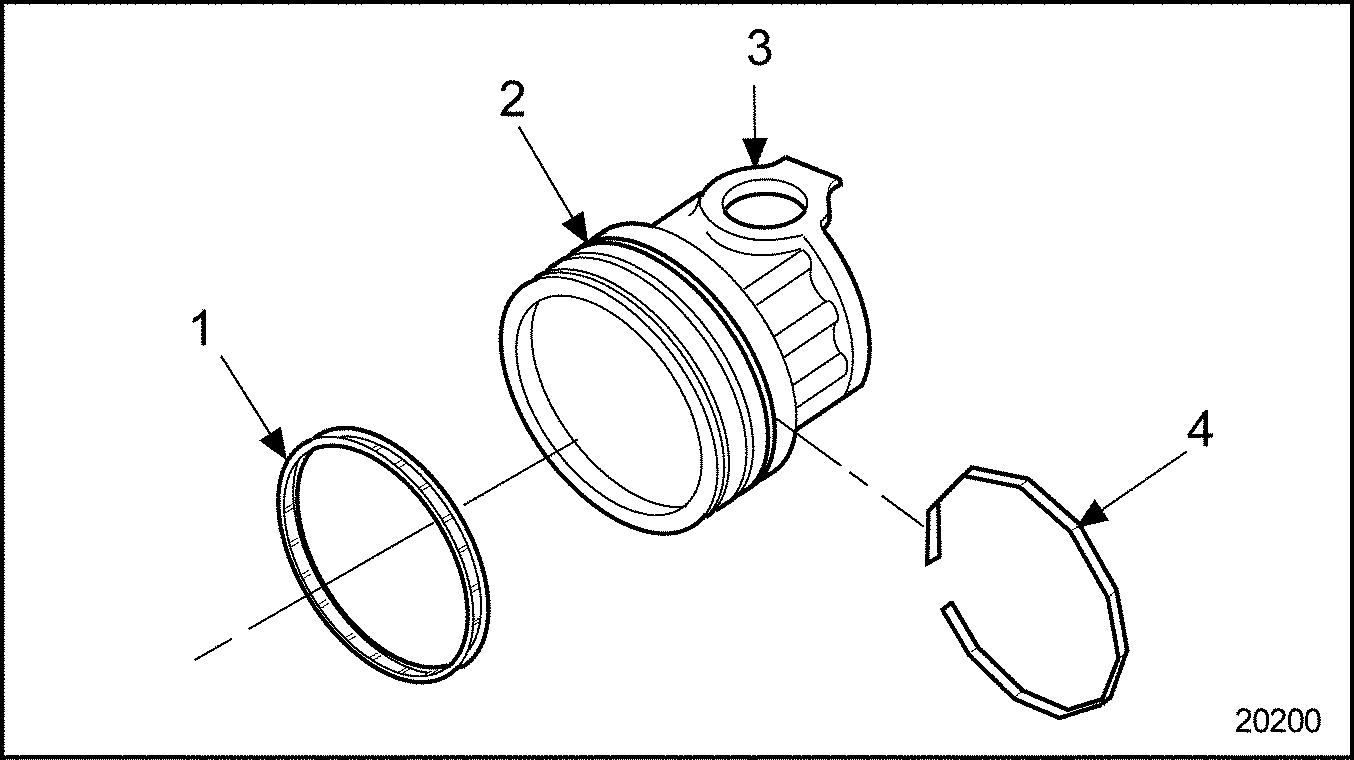
1. Oil Control Ring
3. Piston
2. Oil Control Ring Groove
4. Oil Control Ring Expander
Figure 13. Piston Ring Installation (Diesel)
- Install the oil control ring by hand. See Figure
"Oil Control Ring Installation (Diesel)"
.
Note: The oil control ring may be installed in either direction.
Note: Install expander into inside diameter groove of ring with expander spring gap located 180° from the oil control ring gap.
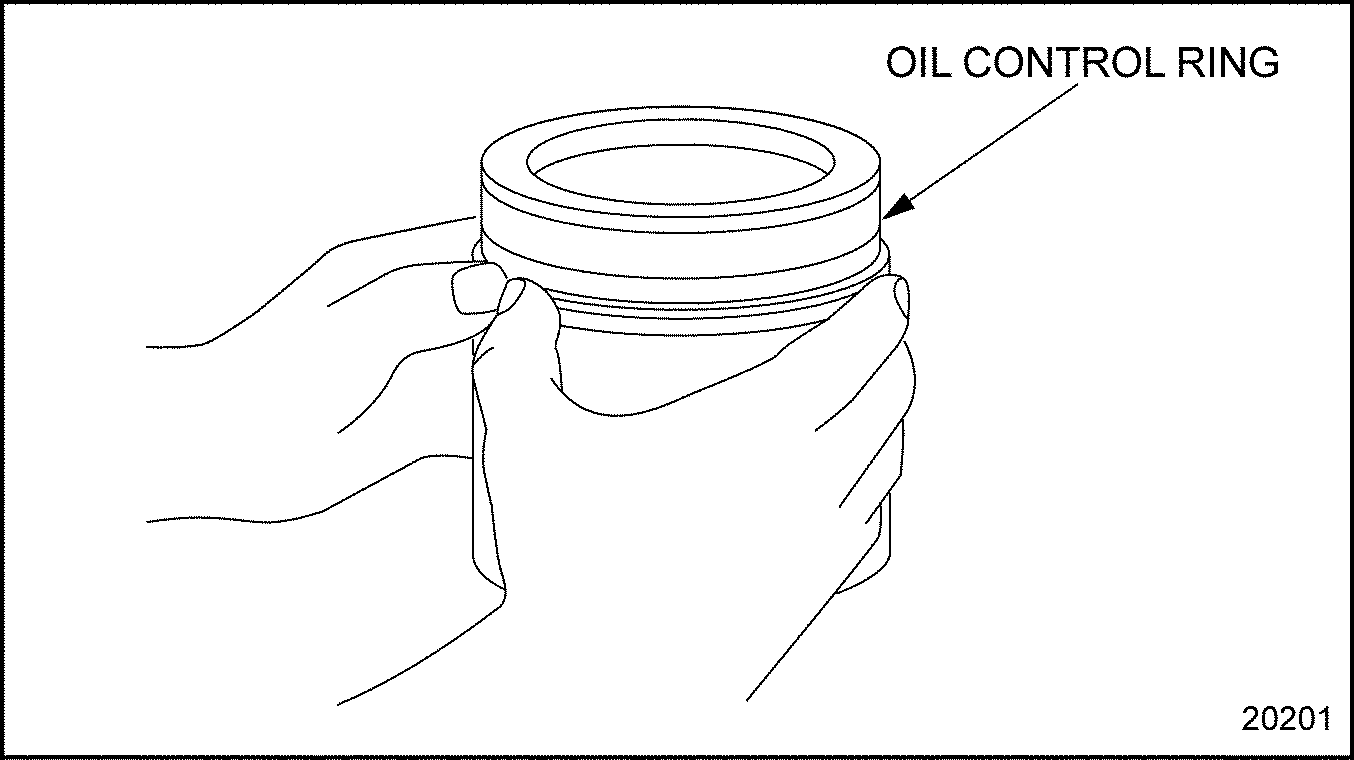
Figure 14. Oil Control Ring Installation (Diesel)
Note: The oil control ring expander has a white paint stripe. Make sure the paint mark can be seen after the oil control ring is installed at ring gap.
Install the fire and compression rings as follows:
NOTICE: |
|
To avoid breaking or overstressing the rings, do not spread them any more than necessary to slip them over the piston dome. |
- Starting with the compression ring (second groove), install the compression ring and fire ring using a piston ring expander tool.See Figure "Piston Ring Positioning (Diesel)" . Make sure the identifying dimple on the rings is installed up, toward the dome of the piston. See Figure "Fire and Compression Ring Identification" for ring identification and locations.
- Stagger the ring gaps around the piston. See Figure
"Piston Ring Positioning (Diesel)"
.

Figure 15. Piston Ring Positioning (Diesel)
- Refer to "1.21.4 Assembly of Piston and Connecting Rod Assembly" for piston and connecting rod assembly procedure.
Section 1.19.6
Assembly of Series 60G Piston Rings
Install the oil control ring for the Series 60G engine as follows:
- Install the expander in the bottom groove of the piston.
- Install the upper and lower rails ensuring one is on the upper side of the expander and the other is on the lower side of the expander.
Note: The expander and both rails may be installed with either side up. There is no "football" mark on any of the three oil ring components for natural gas engines.
- Orient the ring gaps of the rails 180 degrees apart so that they align with the paint marks on the expander. The expander should be 90 degrees from the oil ring gaps.
Install the compression and fire ring for the Series 60G engine as follows:
- Install the compression ring (rectangular cut shape) in the second groove of the piston, using a piston ring expander tool.See Figure
"Installation of Compression Ring"
.
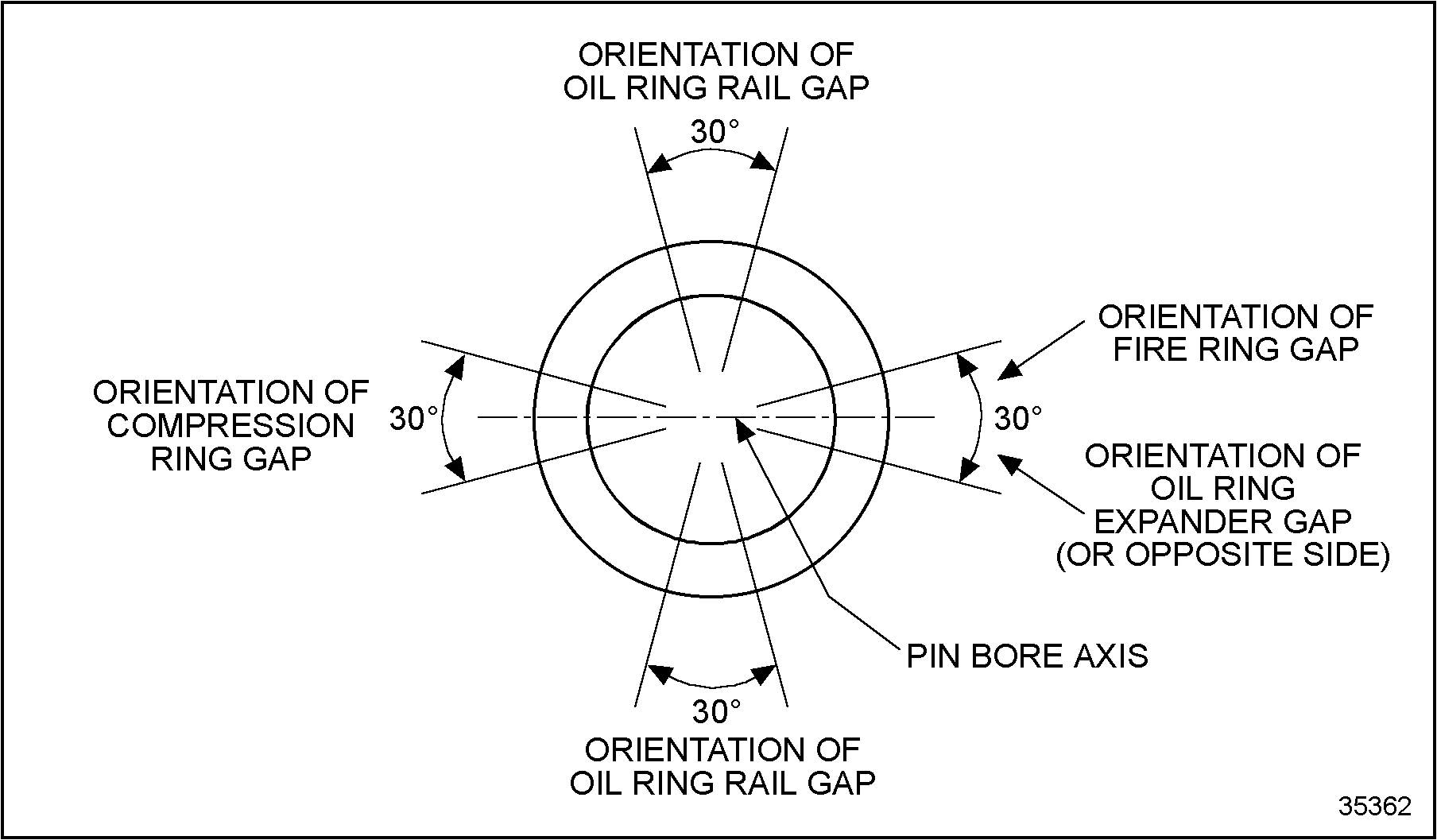
Figure 16. Installation of Compression Ring
- Install the fire ring in the top groove of the piston, using a piston ring expander tool.
- Stagger the ring gaps around the piston. See Figure
"Top View of Piston Dome"
.

Figure 17. Top View of Piston Dome
- Refer to "1.21.4 Assembly of Piston and Connecting Rod Assembly" for piston and connecting rod assembly procedure.
| Series 60 Service Manual - 6SE483 |
| Generated on 10-13-2008 |